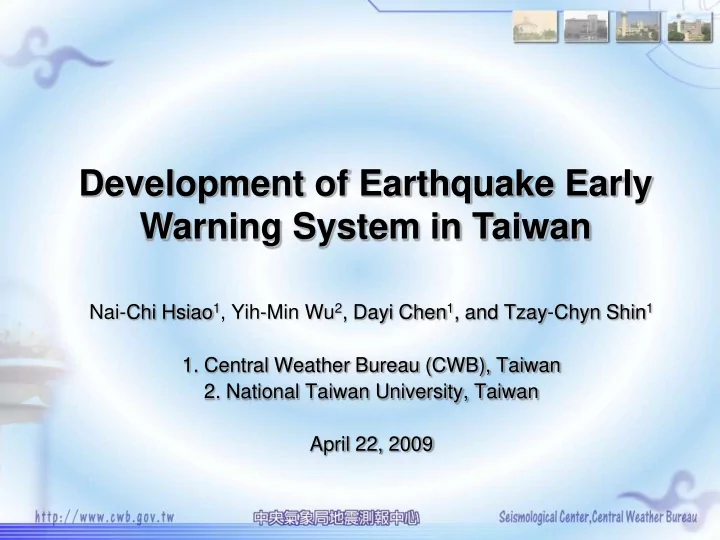

Development of Earthquake Early Warning System in Taiwan Nai-Chi Hsiao 1 , Yih-Min Wu 2 , Dayi Chen 1 , and Tzay-Chyn Shin 1 1. Central Weather Bureau (CWB), Taiwan 2. National Taiwan University, Taiwan April 22, 2009
Outline Introduction – motivation and chance Current EEW system New proposed system Plan for EEW promotion 2
Seismic Island 1980~2009, totally 87 Eqs
Real-time strong-motion network Accelerometer - 102 stations (20km averaged spacing) 16 bits resolution ± 2g Max. amplitude Telemetry - Real-time data stream (RTD) 4.8K dedicated telephone line Sampling rate 50 sps 0.2 sec averaged delay Data processing - Taipei data center Windows-based workstation
Real-time strong-motion network Accelerometer - 102 stations (20km averaged spacing) 16 bits resolution ± 2g Max. amplitude Telemetry - Real-time data stream (RTD) 4.8K dedicated telephone line Sampling rate 50 sps 0.2 sec averaged delay Data processing - Taipei data center Windows-based workstation
Current EEWS in Taiwan Based on a real-time strong-motion network A virtual sub-network approach for EEW experiment was carried out at first (Wu et al., 1999) P-wave methods proposed by Allen and Kanamori (2003) , and Wu and Kanamori (2005) were also tested for EEW capabilities lately (Hsiao, 2007) Other researches for EEW application including shake maps generation (Wu et al., 2001; Hsiao, 2007) and seismic loss estimation (Wu et al., 2002) were proceeded as well 6
Virtual sub-network approach
Performances for VSN 0.28 5.46 6.41 km ~17 sec 4.66 4.73 km 8
Pd discriminator 3 sec P wave 9
Magnitude estimated M max c p 0.40 10
yes Compute Estimate M Pd > 0.1 from Pd M yes Network Create M > 6.0 triggered shakemap VSN algorithm from coming signals M 7.1 2002/3/31 M 7.0 Offshore Hualien earthquake
yes Compute Estimate M Pd > 0.1 from Pd M yes Network Create M > 6.0 triggered shakemap VSN algorithm from coming signals M 6.4 2006/4/1 M 6.5 Taitung earthquake
New proposed EEW system All seismographs installed by CWB are included for EEW evaluation Use the Earthworm as the platform of different seismic data format integration Pd and are used to estimate magnitude c 13
CWB seismographic network New established stations 14
Flowchart of new proposed system EEW Data loggers: Programs for receiving real-time data: Scream, GeoHub, rtdrec There exists corresponding Earthworm’s modules for data importing, such as scream2ew, Import_generic, slink2ew, rtd2ew, s132ew 15
Flowchart of new proposed system EEW Sniffwave4eew: Open the share memory for EEW Extract data of a certain station from Wave_Rings in Earthworm for trigger judgment in real-time Pick P arrival and calculate Pa , Pv , Pd , and while c triggering Put obtained P wave parameters into the share memory 16
Flowchart of new proposed system EEW TcPd: Check P wave parameters of stations in the share memory If reach trigger threshold, calculate , and while the M M P c d hypocenter is obtained Create EEW report Revise EEW report when more data come in 17
Preliminary test for new system 0.48 0.34 12.01 13.01 km 20.2 4.9 sec 18
Plan for EEW promotion in Taiwan The rapid earthquake reports issued by the EEW system are not available to the general public, except for experimental purposes by some relevant organizations such as railway administration, rapid transit companies, and disaster prevention agencies etc. Encouraged by the recent successful examples in the research and application of EEW system in Japan, a joint program to promote the EEW system with the participation of various organizations will proceed in the near future in Taiwan. 19
Promotion plan Establish the Concentrated promotion mechanism Policy Investment and policy Ratification Develop the regional EEW and on-site EEW Development and integration systems at the same time of key technology • Regional EEW technology • On-site EEW technology • Evaluation of communication channels • Investigation of user demands Apply the regional EEW system First stage Develop the on-site EEW system Technology Construct the prototype systems and testing Development School: Regional EEW, On-site EEW, Alarms, Broadcasting system Emergency response institutions: Regional EEW, Alarms, Integration of regional and Second stage Broadcasting system on-site EEW systems Transportation system: Regional EEW, On-site EEW, Alarms, Broadcasting system, Automatic control Launch formal systems and deploy applications Establish associated measures for application Hospital: Regional EEW, On-site EEW, Alarms, Broadcasting system, Automatic control Elevator: Regional EEW, On-site EEW, Automatic control Application System integration and product certification Building: Regional EEW, On-site EEW, Alarms, Deployment Technology transfer and industry promotion Broadcasting system, Automatic control Education, training, and drills High-tech factory: Regional EEW, On-site EEW, Alarms, Related regulation draft Broadcasting system, Automatic control 2016 2009 2010 2011 2012 2013 2014 2015 20
Summary The performances for current EEWS: Epicenter deviation: 5.46 6.41 km Depth deviation: 4.66 4.73 km Magnitude deviation: 0.28 Reporting time: ~17 sec Applying P-wave method into current EEW system, a 10- second response time for inland earthquake can be achieved. And the uncertainty for magnitude estimation by Characteristic periods of the initial P waves is about 0.4. A new EEWS based on Earthworm system has been tested now A promotion plan for EEW by cooperative organizations has been drawn up in Taiwan in the coming years 21
The End Thank you for your attention!
Recommend
More recommend